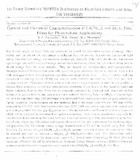| dc.contributor.author | Musembi, R.J. | |
| dc.contributor.author | Munji, M.K | |
| dc.contributor.author | Tsisarnbo, S. R | |
| dc.date.accessioned | 2014-04-28T06:57:15Z | |
| dc.date.available | 2014-04-28T06:57:15Z | |
| dc.date.issued | 2012 | |
| dc.identifier.citation | Optical and Electrical Characterization of Cd:JxNil:xS and Sb2S3 Thin FiIm s fo r Ph0to v 0Ita jcAp Plie 3tion s S. R. Tsisarnbo", M.K. Munj i', R.J. Musembi2 'Department of Physics: Kenyarta University, P.O Box 43844 GPO Nairobi- Kenya 20epal1ment of Physics, University of Nairobi; P.O Box 30 197- 00 I00 GPO 0!airobi-Kenya. | en_US |
| dc.identifier.uri | http://hdl.handle.net/11295/66055 | |
| dc.description.abstract | The limited supply of fossil fuels has motivated the search for alternative sources of energy. Much
Interest now focuses 011 the vast amount of radiation from the sun and thus devices that COnveJ1 light
energy into electrical energy are becoming increasingly' desirable. Solar cells are devices that convert
light energy into useful electrical energy and are fabricated using aileast the active layer being able to
absorb energy from the suns radiation. They are formed by heterojunctions and hornojunctions.
Hererojunction and hornojunction solar cells grown on glass substrates require an absorber layer and a
wide band-gap window layer of optimum optoelectronic properties W form the P-II junction and then
transparent conducting ox-ides (TCO) and specific metal contacts (lit used !"c'r L11.,)Ih front and bad:
electrical contacts. Efficiencies of these solar cells depend on various dep()~itiol1 methods and conditions
because these conditions control the optoelectronic properties of tile lavers ln this research, Cadmium
Nickel Sulphide (CdNiS) thin films will be prepared, optimized by chemical bath deposuion (CBD)
technique on glass substrates and used as a window material Antimony Sulphide (SbZS3 ) absorber layer
will also be deposited using CBD technique and optimized from aqueous solutions on glass substrates.
Optical properties like reflectance and transmittance data in the range from 300 nm- J 100 11m will be
measured by UV-V1S -NlR Spectrophotometer type DUV 3700 and used to calculate other optical and
solid state properties like band gap (Eg), refractive index (n), extinction coefficient (k) and absorbance (0.)
which will be analyzed to determine how optical conductance. transminance. absorbance \3ry with the
conditions of deposition using the Scout Software. Electrical resistivity \,ill be determined using the Four
Point Probe. Alpha-step 500 surface profi lorneter (Tencer) will be used to determine film thickness Solar
cell properties like the current versus voltage characteristics (I-V) will be studied using Solar Cell
Simulator. Conditions that give CdxNi1_XS and SbZS3 optimum optical and electrical properties will then
be selected and used to fabricate a CdxNi1-XS /Sb
z53 photovo haic cell. The phorov o ltaic cell's
performance characteristics like short circuit current (lse), open circuit voltage (Voe), fill factor (FF) and
conversion efficiency (11) will be calculated and discussed. Energy Dispersive X-rays (EDX) will be used
to determine the elemental composition and chemical state ofCdXNij_XS and Sbz53 thin films. | en_US |
| dc.title | Optical and Electrical Characterization of Cd:JxNi_:xS and Sb2S3 Thin FiIm s for Photov0Itaic Application s | en_US |

